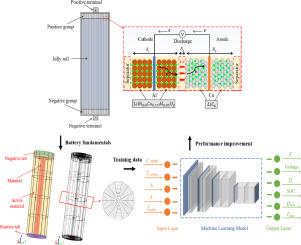Deep learning from three-dimensional lithium-ion battery multiphysics model part I: Data development
IF 9.6
Q1 COMPUTER SCIENCE, ARTIFICIAL INTELLIGENCE
引用次数: 0
Abstract
Fast growing demands for electric vehicles require better longevity, safety and reliability for next-generation high-energy battery technologies. A data-centered battery management system is thus desired to interpret complex battery data and make decisions for properly managing multi-physics battery dynamics. Nowadays, Battery informatics are emerging as promising solutions by leveraging advanced machine learning tools to deliver accurate prediction of battery performance, health and safety, but is hurdled by a scarcity of data. To mitigate this issue, this study presents one of the first studies for data development through both experimental studies and three-dimensional (3-D) multi-physics modeling to underpin a deep learning framework with in-depth examination for battery performance and thermal risk prediction. Specifically, Part I focused on the development of the battery model which was thoroughly validated and analyzed to guarantee the model accuracy by two steps: firstly, we validated the multi-physics model against two commercial Lithium-ion batteries, i.e., Panasonic NCR18650B and 18650BD; Then, the coupling between thermal and electrochemical battery behaviors were analyzed deeply to demonstrate insights obtained from the model, such as voltage evolution and maximum local temperature (hot spot). The developed model proves to be capable of providing insightful and reliable data for the training of convolutional neural network and long short-term memory (CNN-LSTM) in part II.

三维锂离子电池多物理场模型的深度学习 I 部分:数据开发
电动汽车需求的快速增长要求下一代高能电池技术具有更长的使用寿命、更高的安全性和可靠性。因此,我们需要一个以数据为中心的电池管理系统来解读复杂的电池数据,并为正确管理多物理场电池动态做出决策。如今,电池信息学正成为一种前景广阔的解决方案,它利用先进的机器学习工具对电池性能、健康和安全进行准确预测,但却因数据匮乏而难以实现。为缓解这一问题,本研究通过实验研究和三维(3-D)多物理场建模,首次提出了数据开发研究,为深度学习框架提供了基础,并对电池性能和热风险预测进行了深入研究。具体来说,第一部分侧重于电池模型的开发,并通过两个步骤对模型进行了全面验证和分析,以确保模型的准确性:首先,我们以松下 NCR18650B 和 18650BD 这两种商用锂离子电池验证了多物理场模型;然后,深入分析了电池热行为和电化学行为之间的耦合,以展示从模型中获得的见解,如电压演变和最高局部温度(热点)。事实证明,所开发的模型能够为第二部分的卷积神经网络和长短期记忆(CNN-LSTM)训练提供具有洞察力的可靠数据。
本文章由计算机程序翻译,如有差异,请以英文原文为准。
求助全文
约1分钟内获得全文
求助全文
来源期刊

Energy and AI
Engineering-Engineering (miscellaneous)
CiteScore
16.50
自引率
0.00%
发文量
64
审稿时长
56 days
 求助内容:
求助内容: 应助结果提醒方式:
应助结果提醒方式:


